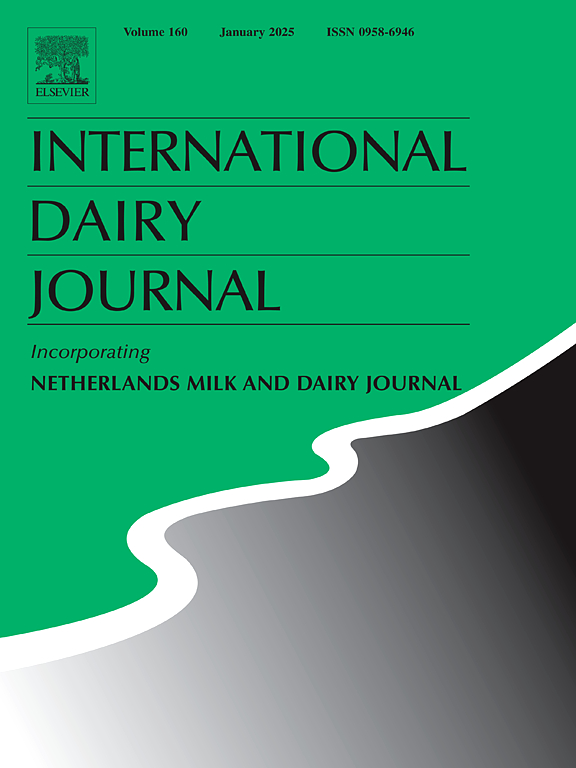Bacterial and fungal profiling of Maltese sheep cheese with amplicon metabarcoding
IF 3.4
3区 农林科学
Q2 FOOD SCIENCE & TECHNOLOGY
引用次数: 0
Abstract
This study aimed to investigate the seasonal variability of bacterial and fungal communities in raw sheep milk and Ġbejna from the Maltese Islands using 16S and ITS-based NGS. Firmicutes and Proteobacteria emerged as dominant bacterial phyla, with Lactococcus lactis, Hafnia alvei, and Streptococcus among the most prevalent species, while L. lactis were consistently abundant regardless of conditions in all samples. Fungal profiling revealed a predominance of Basidiomycota and Ascomycota, with Cutaneotrichosporon curvatus enriched in milk, while Trichosporon insectorum and Kluyveromyces lactis were dominant in dried cheeses. Alpha diversity (Chao1, ACE, Shannon) for fungal microbiota showed no significant seasonal variation, while bacterial microbiota exhibited significantly higher richness in summer than in winter samples. Additionally, beta diversity metrics indicated that cheese microbiomes were strongly shaped by geographical origin rather than sample type. The presence of potential spoilage or opportunistic bacteria and fungi highlights the need for improved hygiene control and fermentation conditions during cheese production. This is the first study to characterise the microbial diversity of Maltese ġbejna using NGS, revealing seasonal and regional variations that contribute to its cultural and economic value.
用扩增子元条形码分析马耳他羊奶酪的细菌和真菌
本研究旨在利用16S和基于its的NGS分析马耳他群岛生羊奶和Ġbejna中细菌和真菌群落的季节性变化。厚壁菌门(Firmicutes)和变形菌门(Proteobacteria)成为优势菌门,乳酸乳球菌(Lactococcus lactis)、肺泡Hafnia alvei和链球菌(Streptococcus)是最常见的菌种,而乳酸乳杆菌(L. lacactis)在所有样品中无论条件如何都始终丰富。真菌分析结果显示,担子菌和子囊菌群占主导地位,牛奶中富含cutanetrichosporon curvatus,而干奶酪中则以食虫Trichosporon和Kluyveromyces lactis为主。真菌菌群的α多样性(Chao1, ACE, Shannon)没有明显的季节变化,而细菌菌群的丰富度在夏季显著高于冬季。此外,β多样性指标表明,奶酪微生物组受到地理来源的强烈影响,而不是样品类型。潜在的腐败或机会性细菌和真菌的存在强调了在奶酪生产过程中需要改善卫生控制和发酵条件。这是第一个使用NGS描述马耳他ġbejna微生物多样性的研究,揭示了有助于其文化和经济价值的季节和区域变化。
本文章由计算机程序翻译,如有差异,请以英文原文为准。
求助全文
约1分钟内获得全文
求助全文
来源期刊

International Dairy Journal
工程技术-食品科技
CiteScore
6.50
自引率
9.70%
发文量
200
审稿时长
49 days
期刊介绍:
The International Dairy Journal publishes significant advancements in dairy science and technology in the form of research articles and critical reviews that are of relevance to the broader international dairy community. Within this scope, research on the science and technology of milk and dairy products and the nutritional and health aspects of dairy foods are included; the journal pays particular attention to applied research and its interface with the dairy industry.
The journal''s coverage includes the following, where directly applicable to dairy science and technology:
• Chemistry and physico-chemical properties of milk constituents
• Microbiology, food safety, enzymology, biotechnology
• Processing and engineering
• Emulsion science, food structure, and texture
• Raw material quality and effect on relevant products
• Flavour and off-flavour development
• Technological functionality and applications of dairy ingredients
• Sensory and consumer sciences
• Nutrition and substantiation of human health implications of milk components or dairy products
International Dairy Journal does not publish papers related to milk production, animal health and other aspects of on-farm milk production unless there is a clear relationship to dairy technology, human health or final product quality.
 求助内容:
求助内容: 应助结果提醒方式:
应助结果提醒方式:


